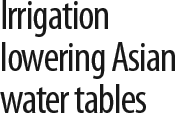20 feet:
Potential height of a flash flood's wall of water.
9 percent
Chance of a home suffering fire damage during a 30-year mortgage.
26 percent
Chance of a home suffering flood damage during a 30-year mortgage.
Water particles grow, collide, break apart and reform within a cloud before falling as rain. The smallest measure that could be called a drop—able to fall from the sky— is 0.5 mm. The largest? About 5.5 mm before the drop is likely to split apart.
Since the reservoir Lake Powell started filling in the mid-1960s, the Colorado River has rarely reached the sea. A flow gage at the beginning of the river’s delta, still miles from the sea, recorded no water at all in 23 of the 35 years between 1965 and 2000.
16.4 > 9.6I
In the years leading up to the 1922 Colorado River Compact (the law that still regulates the river’s water allocations), the river’s flow was unusually high, and negotiators expected they’d always have about 16.4 million acre feet to divvy up. During 2000-2004, the most severe drought on record, the average flow was 9.6 million acre feet.
Irrigation lowering Asian water tables

In heavily irrigated Northern India, Pakistan, and Bangladesh, groundwater is disappearing at a rate of about 54 km3 per year, according to new satellite measurements.
“This is probably the largest rate of groundwater loss in any comparably sized region on Earth,” CIRES Fellow John Wahr and colleagues wrote in a paper published in Geophysical Research Letters this year.
The research team—Wahr, Virendra Tiwari at the National Geophysical Research Institute in India, and Sean Swenson at the National Center for Atmospheric Science in Boulder, Colo.—used NASA’s GRACE satellite (see p. 12), to calculate the rate of groundwater loss in the region, where water availability is known to be declining. From satellite gravity measurements, the scientists found an extremely high rate of water loss—54 km3 per year, +/- 9 km3—enough to make the regional water table drop about 10 cm a year.
“This trend, if sustained, will lead to a major water crisis in this region,” the researchers concluded.
The figures are comparable with groundtruth, according to the International Water Management Institute. More and more farmers are growing irrigated crops in the region, and the use of small, electrical pumps to pull up water is growing quickly. In some aquifers, groundwater is increasingly tainted with salts and other chemicals, including the toxin arsenic, Wahr and his colleagues noted.
Regional water use is very difficult to estimate from the ground-up for lack of consistent monitoring. The new study suggests that the Indian Central Ground Water Board’s latest estimate, from the 1990s, is no longer accurate, that groundwater extraction rates are about 70 percent higher today. But the findings also mean that satellite data could be used to get regional water managers up-to-date information on groundwater storage in the region—an important step toward creating a sustainable water-management plan for the 600 million people who live there.![]()


